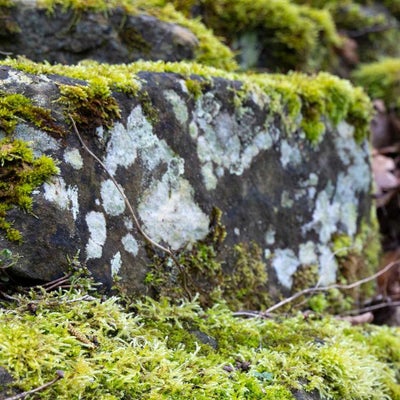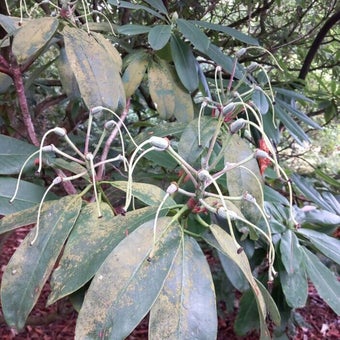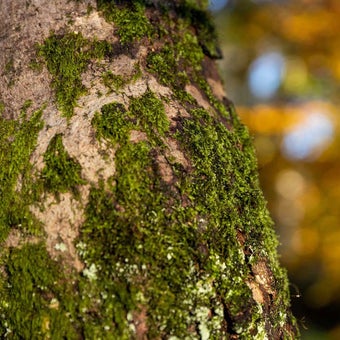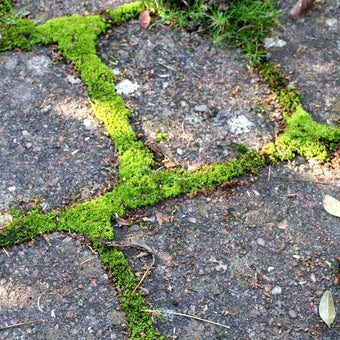
Quick facts
These organisms are often overlooked, but viewing them close-up reveals their beauty and diversity
Although small, they are an important part of garden ecosystems
The UK has over 2,000 species of lichens, over 700 species of mosses and approximately 300 species of liverworts
Algae, liverworts and mosses all require a moist environment to reproduce
Some lichens and mosses can tolerate periods of dry and bright conditions, allowing them to grow in a wider range of habitats
Algae
What are algae and where do they grow?
Algae are simple, plant-like organisms. They can photosynthesise (harness the energy in sunlight) but don’t have true roots, stems or leaves. There are thousands of different species of algae, varying greatly in size and appearance, from single-celled species to metres-long giant kelp in our oceans. Below are some examples of algae you might find in wet, shady or poorly drained parts of your garden:
In ponds and lakes algae may be single-celled types, such as Chlamydomonas and Chlorella that turn the water green, or they may be thread-like, such as Cladophora and Spirogyra, that form hair-like blanket weed. They proliferate in water, including water butts, where light and are abundant.
On paving, patios, stonework, garden furnitureandgreenhouses, algae often form a green film or powdery deposit. Those with yellow or orange colouring, such as Trentepohlia aurea, grow on hard surfaces, particularly rocks and old walls.
Tree trunks and branches host algae that appear as green, orange or rusty-red powdery deposits; these are most likely to be seen on the northern side of a tree. Trentepohlia is a common type of algae on trees in the UK; the species T. umbrina is easily noticed, due to its conspicuous rusty-red colour.
In borders and containers, algae can form a thin, green, powdery layer. Algae can also grow on the surface of evergreen leaves, making glossy leaves look dull.
Algae-like Nostoc grow on gravel, tarmac, concrete paving and soil. They are cyanobacteria (bacteria that photosynthesises) but are often mistaken for algae. Nostoc species seen in gardens form greenish, jelly-like growths after rain, which become black and crusty when they dry out. Its strange appearance is reflected in its common names, which include star jelly, witch’s jelly and troll’s butter.

Did you know?
Seaweeds (species of algae) are valued by many gardeners as organic liquid plant food containing major plant nutrients and trace elements. Fresh seaweeds have been used for centuries in coastal areas as a soil improver.
The British Phycological Society is a charity committed to the study of algae. If you are interested in learning more about these fascinating organisms, their website includes lists of publications and information on how to become a member.
Lichens
What are lichens and where do they grow?
A lichen is not a single organism; it is a symbiotic (mutually beneficial) association between a fungus and an alga, or a fungus and a cyanobacterium. There are more than 2,000 species of lichens in the British Isles; some are very rare and are restricted to specific sites, but most gardens have at least a few species. Lichens can be found on trunks, stems and branches of trees and shrubs, on paths, patios, paving and walls, and less commonly in lawns. Most lichens are silver-grey, grey-green, yellow or orange. Those that appear on trees and shrubs are often green or grey.
Lichen species are often difficult to identify, but for ease of recognition they can be divided into three types:
Foliose lichens are flat and creeping with leaf-like lobes. They are loosely attached across their base to the trees, stones or turf they grow on. Xanthoria parietina (common orange lichen) is one of the most common foliose lichens. Its yellow, orange or grey lobes are seen in a range of urban, rural and coastal habitats on various surfaces, including trees, cement, rocks, walls and roof tiles. Another common group of foliose lichens are the Peltigera species (dog lichens); they appear in lawns and form flat, brown or grey lobes with visible root-like growths underneath.
Fruticose lichens are usually attached by a single point at their base. They grow in an erect or pendulous pattern and give the impression of bush-like plants. Ramalina farinacea (shaggy strap lichen) is a fruticose lichen commonly found in the UK, where it grows on twigs, branches and sometimes on rocks; it has pale grey-green tufted growth.
Crustose lichens appear as thin, flat crusts, sometimes with distinct margins, that grow directly on their substrate. They are common on paving and timber structures, such as garden benches, and produce interesting mosaics that, given a few years, help to blend in the harsh appearance of new timber, brick or stone. Protoparmeliopsis muralis (stonewall rim lichen) is a crustose lichen commonly seen on man-made surfaces in lowland Britain but can also be found on sawn timber. It is greenish-grey to yellowish-grey and forms patches up to 10cm in diameter.

Did you know?
Many lichens are sensitive to air pollution. Industrialisation in Britain increased sulphur dioxide levels, leading to the decline of many species in urban and industrial areas. Since the introduction of Clean Air Acts in the 1950s and 60s, lichens are slowly recolonising areas they disappeared from. However, many species are now threatened by high levels of ammonia and nitrogen oxides, a result of intensive animal farming, agricultural activities and exhaust fumes.
If you are interested in lichens, the British Lichen Society website contains lots of useful information, including descriptions and images to help with identification.
Liverworts
What are liverworts and where do they grow?
Liverworts, along with mosses and hornworts, are small, low-growing land plants, collectively known as bryophytes. Liverworts reproduce by spores instead of flowers and seeds. They lack true stems, leaves and roots, but they do have rhizoids (root-like growths) that anchor them to surfaces. They thrive in damp, compacted soils in shady areas. Approximately 300 species of liverworts are to the British Isles, and these can broadly be divided into two types:
Thallose liverworts have a flattened, plate-like body (the thallus) and no leaf-like growths. A common example seen on soil and hard surfaces in gardens is Marchantia polymorpha (common liverwort). Its female plants produce a noticeable star-like umbrella structure. Metzgeria furcata (forked veilwort) is a thallose liverwort often seen on trees (especially ash, sycamore and willow) and shrubs throughout the UK. Its yellowish-green growth attaches closely to and forks at its tips. Pellia epiphylla (overleaf pellia) is another common species, often found on damp soil near rivers and streams, or on wet rocks.
Leafy liverworts, despite their name, don’t have true leaves but have leaf-like structures arranged in two rows, sometimes with a third row on their underside. Frullania dilatata (dilated scalewort) is a common leafy liverwort that is green or brown and the ‘leaves’ have rounded lobes. It is especially tolerant of drying out, so is often seen in well-lit positions, such as high up on the trunks of trees, even in drier parts of the UK. Frullania tamarisci (tamarisk scalewort) is less tolerant of desiccation, and therefore is more common in areas with higher rainfall.

The British Bryological Society has a very informative website that can help with identifying liverworts.
Mosses
What are mosses and where do they grow?
There are over 700 species of mosses in the UK; they vary in form from coarse, loose, green or yellowish-green tufts to densely matted tufts or compact green cushions. Like other early plants, mosses reproduce by spores rather than seed, and generally prefer to grow in damp, shady conditions. They have stems and leaves but instead of roots they have shallow rhizoids (small hairlike structures) that anchor them to surfaces. Habitat loss and climate change have put some species at risk.
A common moss in the UK is Mnium hornum (swan’s neck thyme moss). It grows on woodland floors, preferring acid soils; it can also be found on logs, rocks, the base of tree trunks, and along hedgerows and streams. In spring, its new growth is bright yellowish-green, contrasting with duller, dark green older growth beneath.
Brachythecium rutabulum (rough-stalked feather-moss) is another common moss capable of growing in a range of habitats. It varies in colour and form, making identification challenging, and grows on logs, stumps, soil, rocks, walls and lawns. Other mosses you might find in your lawn include Rhytidiadelphus squarrosus (springy turf-moss), Calliergonella cuspidata (pointed spear-moss) and Polytrichum species (haircap mosses).

Did you know?
Throughout history, people have used sphagnum moss to dress wounds, as its absorbency and antiseptic properties aid healing. Sphagnum moss was collected and used extensively to dress wounds during the First World War.
The British Bryological Society website contains a wealth of useful information on mosses. It has images and identification tips for many species, and information on habitat, distribution, conservation projects, study courses and publications. For information on using mosses in gardens, see our page on the Magic of Moss.
Do I need to get rid of algae, lichens, liverworts and mosses?
In the vast majority of cases there is no need to get rid of algae, lichens, liverworts and mosses. Although they often grow on other plants, they are not parasitic and are just using trunks, branches, twigs or leaves as a surface to grow on. They perform many useful functions within gardens, so allowing them to grow:
- Boosts the of your garden – the UK, with its temperate maritime climate, is particularly rich in algae, lichens, liverworts and mosses. Your garden can support many species within just a tiny patch of growth.
- Provides food and habitats for a large range of garden wildlife – they offer shelter to small creatures, including beetles, spiders, springtails and woodlice, and even smaller microscopic invertebrates such as rotifers, tardigrades and nematodes. Moss is used by garden birds as nesting material and it is a food source for many moths. Lichens are grazed by slugs and snails.
- Reduces soil erosion – even a thin layer of growth helps reduce valuable topsoil being washed away by heavy downpours or blown away by wind.
- Absorbs water – mosses are particularly effective at absorbing water, acting like sponges to soak up rainfall and slow surface water runoff.
- Adds character – algae, lichens, liverworts and mosses give gardens an atmosphere of maturity and permanence. They soften the overall look of man-made surfaces and structures and can add an interesting tapestry of texture and colours.

Did you know?
The UK is rich in native species of algae, lichens, liverworts and mosses. The UK’s number of native moss species is over half that of Europe’s; by comparison, the UK has less than one tenth of Europe’s number of native tree species.
However, there are some situations in gardens when algae, lichens, liverworts and mosses may not be welcome, such as:
- On surfaces that can become slippery – algae can make hard surfaces such as paving, patios, wooden decking, and concrete floors in greenhouses slippery. As a safety measure, it is advisable to get rid of any growth likely to cause slips or falls. See our page on Algae, lichens, liverworts and mosses on hard surfaces for information on prevention and control methods.
- In seed trays and containers – when is damp, algae, liverworts and mosses might grow on the surface and slow or prevent the growth of and small, delicate plants (lichens are so slow growing they are unlikely to cause any issues). Emerging seedlings may struggle to break through a layer of growth above them; this is more likely with very fine seed. Any size plant in a container can suffer if liverworts or mosses form a layer that limits or prevents water soaking down into the compost. See our page on Algae, lichens, liverworts and mosses on borders and containers for information on prevention and control methods.
- On evergreen leaves – a green powdery covering of algae can build up and block sunlight reaching the surface of evergreen leaves; when this happens, and the plant’s overall growth rate slows down. See our page on Algae on leaves for information on prevention and control methods.
- In fine lawns – gardeners wanting an immaculate lawn consisting of only lawn grass species will likely want to get rid of mosses. See our page on Moss in lawns for information on prevention and control measures.
Lichens and algae are sometimes mistaken for fungal growths; if you are an RHS member you can use the Gardening Advice service to identify growths you are unsure about.
How can I encourage algae, lichens, liverworts and mosses to grow in my garden?
Creating some damp, shady areas in your garden is the best way to encourage algae, lichens, liverworts and mosses. This could be as simple as positioning some pots close together so that an area of paving beneath is permanently shaded and regularly wetted when the pots are watered.
The spores of algae, lichens, liverworts and mosses are so tiny they can be transported many miles by the wind. If they land in favourable damp and shady conditions they will germinate, grow and spread, so, with time, suitable species will find their way into your garden. You can encourage their growth on stone structures by painting the surface with a weak yoghurt solution.
Gardeners sometimes introduce liverworts and mosses into their gardens deliberately. Mosses for lawns or as ground cover in borders are available to buy. If introducing liverworts or mosses, check they have been sourced responsibly and never take them from the wild or without the landowner’s permission. In lawns, mosses are encouraged by a lack of aeration, low fertility, acidic soil, wet conditions, excessive shade and close mowing.
Generally, lichens cannot be , and you will need to wait for them to naturally colonise areas of your garden. Many lichen species need good light levels to grow.

















